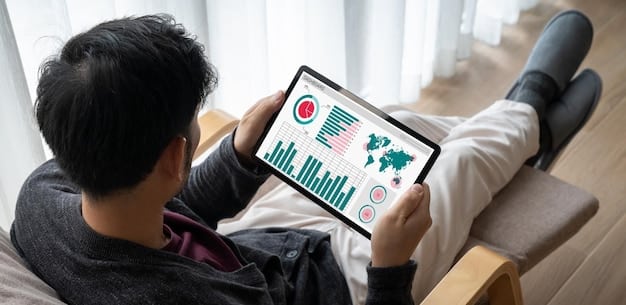Micro-Influencers: Are They the Future of Marketing? ROI Analysis

Influencer marketing is evolving, with micro-influencers increasingly demonstrating higher ROI compared to larger, more traditional influencers, suggesting a shift in marketing strategies towards more authentic and relatable endorsements.
The landscape of influencer marketing is undergoing a seismic shift. While mega-influencers once reigned supreme, a new breed of digital persuaders is emerging: micro-influencers. And guess what? They’re driving a 25% higher ROI.
Is This the End of Traditional Influencer Marketing?
For years, brands have flocked to influencers with massive followings, hoping to tap into their audience and boost sales. But is this strategy still effective? Are brands throwing money at vanity metrics like follower count, or are they truly seeing a return on their investment?
The rise of ad blockers and the decreasing attention spans of consumers are making it harder for traditional advertising to break through the noise. This is where micro-influencers come in. These individuals, typically with followings between 1,000 and 100,000, possess a unique ability to connect with their audience on a personal level.

The Power of Authenticity
Why are micro-influencers so effective? The answer lies in authenticity. Unlike their mega-influencer counterparts, micro-influencers often cultivate a niche audience based on shared interests or passions. This allows them to build trust and credibility with their followers, who view them as genuine peers rather than untouchable celebrities.
- Higher Engagement Rates: Micro-influencers tend to have significantly higher engagement rates (likes, comments, shares) compared to macro-influencers.
- Increased Trust: Their smaller, more intimate communities foster a sense of trust and authenticity.
- Niche Expertise: They often specialize in a specific area, making their recommendations more relevant and impactful.
Micro-influencers offer a unique opportunity for brands to connect with their target audience in a more meaningful way. Their authenticity and expertise make them valuable partners in the quest for authentic connections and increased ROI.
What Makes Micro-Influencers Tick?
Micro-influencers aren’t just smaller versions of traditional influencers. They operate within a different ecosystem, driven by different motivations and values. Understanding these nuances is crucial for brands seeking to collaborate effectively.
One key difference is their motivation. While mega-influencers are often driven by financial gain and brand partnerships, micro-influencers are typically more passionate about their niche and their community.
The Community Connection
Micro-influencers prioritize building a strong community around their content. They actively engage with their followers, respond to comments, and foster a sense of belonging. This level of interaction is often impossible for influencers with millions of followers.
They genuinely care about their audience and are more likely to recommend products or services that they believe in, even if it means turning down lucrative sponsorship opportunities. Brands that recognize and respect this ethos are more likely to forge successful partnerships.

The Perks of Being Niche
Another advantage of micro-influencers is their niche expertise. They often specialize in a specific area, such as sustainable living, vegan cooking, or indie gaming. This allows them to attract a highly targeted audience that is genuinely interested in their content.
- Targeted Audience: Reach a specific demographic or interest group.
- Relevant Content: Recommendations align with audience interests.
- Increased Credibility: Expertise within a specific field builds trust.
Brands that align with these niches can leverage micro-influencers to reach a highly engaged and relevant audience. This targeted approach can lead to higher conversion rates and increased brand loyalty.
The ROI Revolution: Why Micro-Influencers Outperform
The numbers don’t lie. Study after study has shown that micro-influencers often deliver a higher return on investment (ROI) compared to their larger counterparts. But why is this the case?
Again, it boils down to authenticity and engagement. Micro-influencers have a closer relationship with their audience, which translates into higher levels of trust and influence. When they recommend a product or service, their followers are more likely to take notice and make a purchase.
Cost-Effectiveness
One of the most significant advantages of micro-influencer marketing is its cost-effectiveness. Micro-influencers typically charge less for their services than macro-influencers, making it an accessible option for small and medium-sized businesses (SMBs) with limited marketing budgets.
This affordability allows brands to experiment with different micro-influencers and campaigns, optimizing their approach and maximizing their ROI. By diversifying their influencer marketing strategy, brands can reach a wider audience and achieve better results.
Long-Term Value
Beyond immediate ROI, micro-influencer marketing can also deliver long-term value. By building relationships with these influencers, brands can create a network of advocates who will continue to promote their products or services organically.
- Brand Loyalty: Micro-influencers can become long-term brand ambassadors.
- Organic Reach: Positive word-of-mouth marketing generates organic leads.
- Community Building: Engaged communities contribute to brand growth.
This long-term approach to influencer marketing can foster brand loyalty, generate organic reach, and contribute to overall brand growth.
How to Find and Vet the Right Micro-Influencers
Finding the right micro-influencers for your brand is crucial for a successful campaign. But with so many individuals vying for attention online, how do you identify the authentic voices that align with your values and target audience?
Start by defining your target audience and identifying the platforms where they spend their time. Then, use relevant keywords and hashtags to search for micro-influencers who are creating content in your niche.
The Vetting Process
Once you’ve identified a few potential candidates, it’s time to dig deeper and vet their profiles. Look for indicators of authenticity, such as genuine engagement, original content, and a consistent brand voice.
It’s also important to check their follower demographics to ensure that they align with your target audience. Tools like Social Blade and HypeAuditor can provide valuable insights into an influencer’s follower base and engagement metrics.
- Authenticity Check: Verify genuine engagement and original content.
- Demographic Alignment: Ensure the follower base matches your target audience.
- Brand Voice Consistency: Confirm their values align with your brand.
Building a Successful Micro-Influencer Campaign
Once you’ve found the right micro-influencers, it’s time to craft a compelling campaign that will resonate with their audience and deliver results. This requires a collaborative approach that respects the influencer’s voice and expertise.
Start by clearly defining your campaign goals and objectives. What do you want to achieve? Are you looking to increase brand awareness, drive sales, or generate leads? Once you have a clear understanding of your goals, you can work with your micro-influencers to develop creative content that aligns with their style and resonates with their audience.
Creative Collaboration
Avoid micromanaging your micro-influencers’ content. Instead, provide them with guidelines and creative freedom, allowing them to develop authentic content that feels natural to their audience. Remember, their authenticity is their greatest asset.
Encourage them to share their ideas and insights, and be open to incorporating their feedback into your campaign. This collaborative approach will result in more engaging and effective content that resonates with their audience.
Transparency and disclosure are key to maintaining trust and credibility. Make sure your micro-influencers are transparent about their sponsored content, using appropriate hashtags like #ad or #sponsored. This will help them maintain their authenticity and avoid alienating their audience.
Measuring the Impact: Tracking Your ROI
Measuring the impact of your micro-influencer campaign is crucial for determining its success and optimizing your future strategies. But how do you track your ROI and assess the effectiveness of your campaign?
Start by setting clear and measurable goals at the outset of your campaign. Are you looking to increase website traffic, generate leads, or drive sales? Once you have defined your goals, you can use a variety of tools and metrics to track your progress.
Key Performance Indicators (KPIs)
Track key performance indicators (KPIs) such as website traffic, social media engagement (likes, comments, shares), and conversion rates. You can also use unique tracking links and promo codes to measure the direct impact of your micro-influencer campaigns on sales.
- Website Traffic: Monitor visits generated from influencer campaigns.
- Social Engagement: Track likes, comments, shares, and mentions.
- Conversion Rates: Measure the direct impact on sales using tracking links.
Regularly analyze your data and make adjustments to your strategy as needed. By continuously monitoring your ROI and optimizing your approach, you can maximize the effectiveness of your micro-influencer campaigns.
| Key Point | Brief Description |
|---|---|
| ⭐ Authenticity | Micro-influencers offer a more genuine connection with their audience. |
| 💰 Cost-Effectiveness | They provide higher ROI compared to mega-influencers. |
| 🎯 Niche Expertise | They specialize in areas that attract targeted audiences. |
| 📈 Engagement | Higher engagement rates translate to better impact. |
Frequently Asked Questions
A micro-influencer is a person who has a smaller, more niche audience, typically between 1,000 and 100,000 followers, and cultivates a strong, authentic connection with their community.
Micro-influencers are typically more effective due to their authentic voice, higher engagement rates, and the trust they build with their niche audience, leading to better conversions.
Look for influencers whose audience aligns with your target demographic and whose values match your brand’s. Check engagement levels and content quality to ensure it resonates with your audience.
Costs vary widely, but micro-influencers generally charge less than mega-influencers. It’s often based on engagement, reach, and the type of content required, offering a more cost-effective solution.
Track metrics like website traffic, social media engagement, conversion rates, and use unique tracking links or promo codes to directly attribute sales from the micro-influencer’s promotions.
Conclusion
The shift towards micro-influencer marketing signals a new era of authenticity and engagement in the digital landscape. By focusing on genuine connections and targeted reach, brands can achieve higher ROI and build lasting relationships with their audience. As consumer preferences evolve, the power of micro-influencers is poised to reshape the future of influencer marketing.





